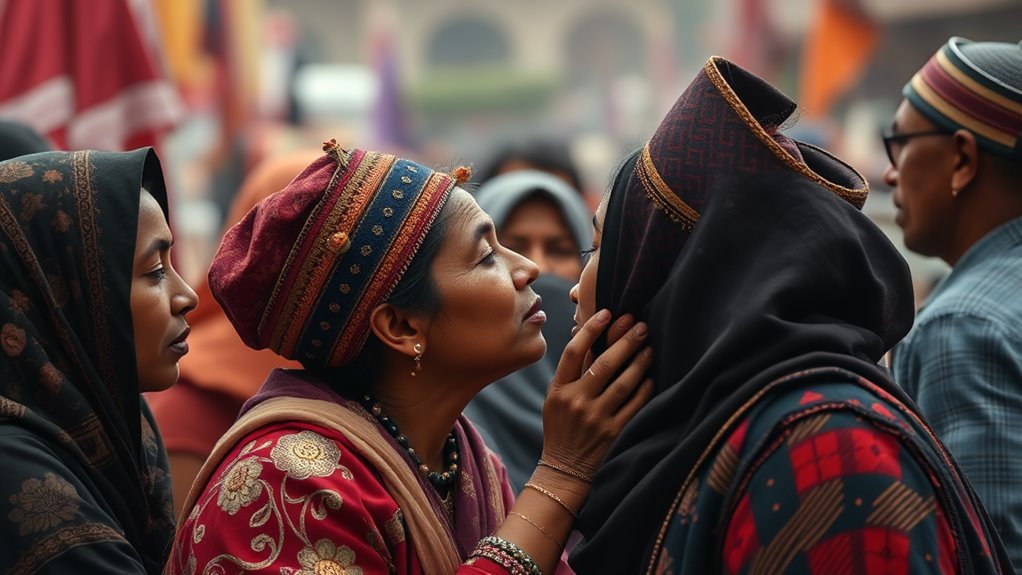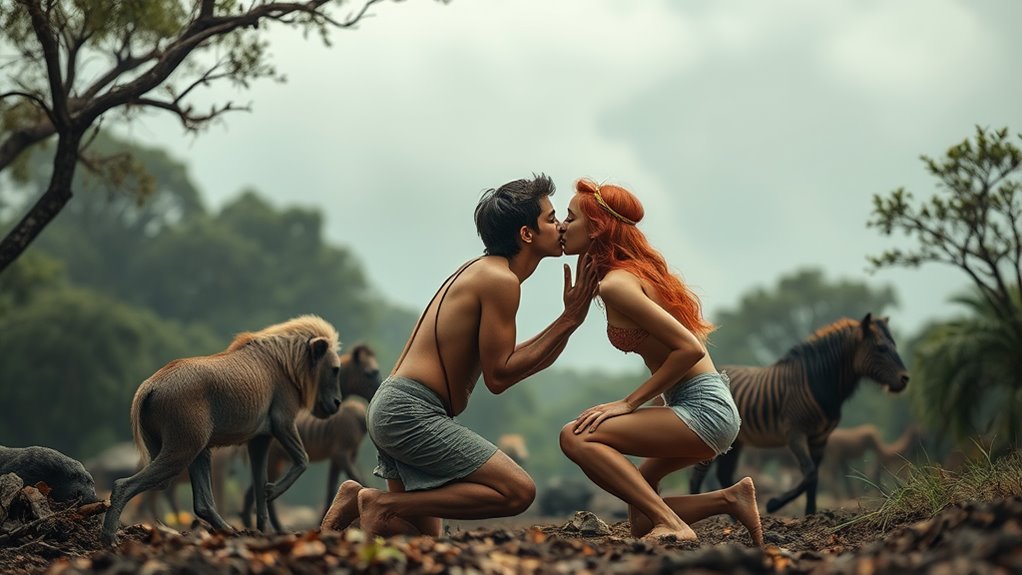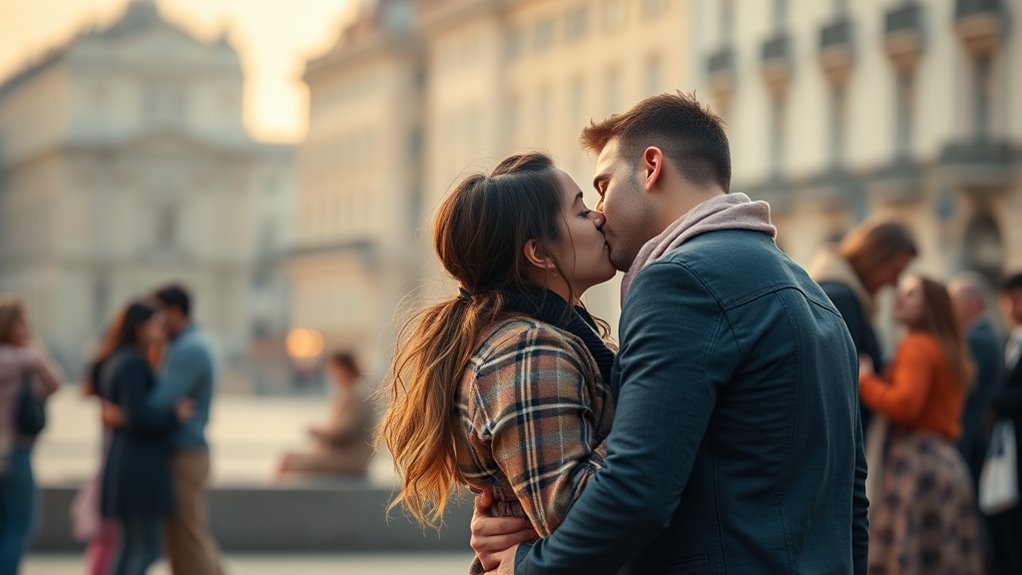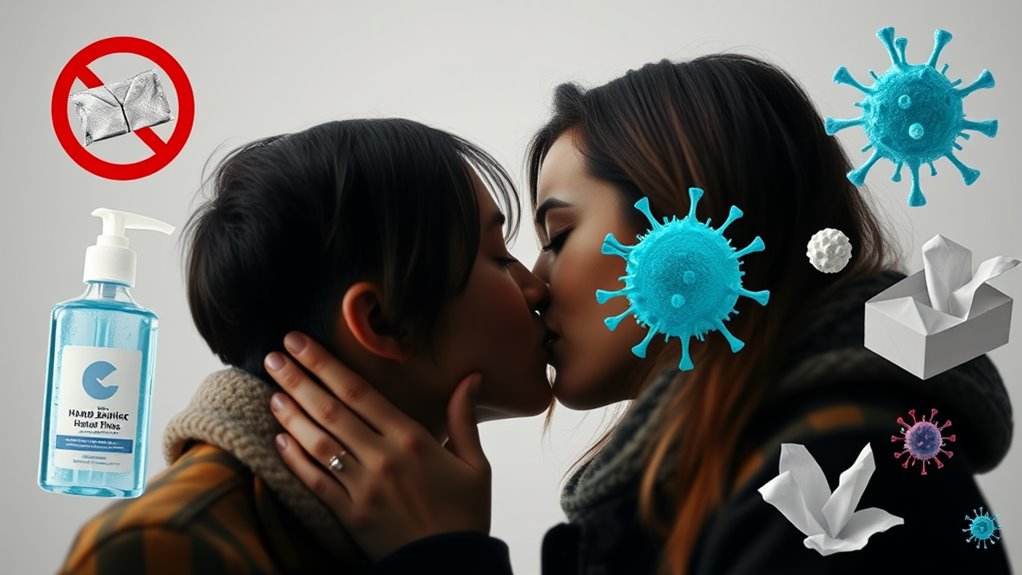Humans likely started kissing around 2500 BCE, with the earliest documented kisses discovered in ancient Mesopotamia. These early kisses were linked to both romantic and familial bonds. Other ancient texts, like the *Mahabharata* and *Kama Sutra*, reference kissing practices from India dating back to around 1500 BCE. As cultures evolved, so did kissing's significance, becoming a common expression of affection across approximately 90% of societies. You'll find that kissing varies greatly worldwide, reflecting unique customs and beliefs. If you keep exploring, you'll uncover even more fascinating insights about the origins and significance of this ancient practice.
Essential Insights
- The earliest recorded kisses date back to ancient Mesopotamia around 2500 BCE, documented on clay tablets.
- Kissing rituals are referenced in ancient Indian texts like the *Mahabharata* and *Kama Sutra* from 1500 BCE.
- Alexander the Great's conquests around 326 BCE helped spread kissing traditions from India to the Western world.
- Approximately 90% of human cultures engage in some form of kissing, showcasing its long-standing significance.
- The Sumerian Barton Cylinder contains the first recorded romantic kiss between deities, indicating ancient origins of the practice.
Historical Evidence of Kissing

Exploring the historical evidence of kissing reveals a rich tapestry of cultural significance and social norms surrounding this intimate act. The earliest recorded evidence of kissing dates back to around 2500 BCE in ancient Mesopotamia, where clay tablets describe both friendly-parental and romantic types of kisses.
You'll find that romantic expressions were often reserved for married couples and conducted in private, reflecting the societal norms of that time. Kissing wasn't just a personal act; it held ritualistic importance as well. In ancient Christian and Hebrew traditions, the "kiss of peace" symbolized goodwill and unity. Interestingly, approximately 90% of human cultures engage in kissing, indicating its widespread significance.
Meanwhile, in Persia, kissing on the mouth indicated equality, while a kiss on the cheek signified a subordinate relationship. This hierarchy showcases how ancient practices influenced social interactions.
Interestingly, the Sumerian Barton Cylinder, a mythological text, contains the first recorded proof of a romantic kiss between deities, emphasizing the profound significance of kissing in both divine and human love. Kissing was also subject to strict regulations; for instance, it was taboo for unmarried individuals, with priestesses believed to lose their voice if they engaged in such romantic expressions.
Throughout various cultures, kissing has evolved, but its roots run deep in our history. From the Vedas to the Old covenant, references to this intimate act highlight its enduring importance across centuries.
Understanding these historical contexts enriches your appreciation for kissing as a complex social expression, deeply woven into the fabric of human connection.
Geographic Origins of Kissing

Kissing, an intimate act with deep cultural roots, traces its geographic origins back to ancient civilizations. The earliest recorded kiss dates back to Mesopotamia, around 4,500 years ago, where kissing was documented on clay tablets. This act was tied to both romantic intimacy and familial bonds, showcasing its multifaceted significance in society. Some anthropologists suggest that kissing originated in ancient Mesopotamia around 2500 BC, highlighting its long-standing presence in human interaction.
In the Indian Subcontinent, kissing rituals likely began around 1500 BC, with references found in the ancient texts like the *Mahabharata* and *Kama Sutra*. As Alexander the Great conquered parts of India in 326 BC, these kissing traditions spread to the West, influencing various cultures.
To give you a clearer picture of the geographic origins of kissing, take a look at this table:
| Region | Time Period | Key Texts/References |
|---|---|---|
| Mesopotamia | 2500 – 4500 BCE | Clay tablets documenting intimacy |
| Indian Subcontinent | 1500 BCE – onward | Mahabharata *Kama Sutra* |
| Global Variations | Various | Anthropological evidence |
While kissing is common in the Middle East, Asia, Europe, and North America, it's less prevalent in Sub-Saharan Africa and New Guinea. Different cultures have their unique forms of kissing, emphasizing the kissing symbolism and the diverse ways people express affection worldwide.
Cultural Context of Kissing

While many people associate kissing with romantic love, its cultural context reveals a rich tapestry of meanings and practices that vary widely around the globe. Kissing rituals differ markedly between societies, reflecting underlying beliefs about affection, respect, and social bonding.
For instance, in some cultures, a kiss symbolizes the fusion of souls, as seen in ancient Indian traditions and Eskimo practices. Here, kissing isn't just a gesture; it embodies a deeper connection that transcends the physical act.
Kissing symbolism often shifts depending on the relationship between individuals. In Ancient Rome, it served as a multifaceted expression that could convey romantic affection, political alliances, or friendly greetings. Additionally, different cultures assign diverse meanings to similar kissing behaviors, highlighting the complexity of this act.
During the Middle Ages in Europe, it evolved further to include non-sexual types of kisses like the 'chaste kiss' or the 'kiss of peace,' emphasizing its versatility.
Even in more contemporary settings, the kiss retains its significance as an emotional expression, often marking special moments in literature and art. This historical development showcases how kissing isn't merely about romance; it carries layers of meaning that resonate across cultures.
Understanding these cultural nuances enriches your appreciation for the act itself. You realize that kissing rituals can symbolize everything from deep love to simple friendship, making it a powerful tool for human connection in various contexts.
Whether it's a quick peck or a lingering embrace, each kiss tells its own story.
Social Norms Surrounding Kissing

The act of kissing varies greatly across cultures, influenced by social norms that dictate when and how it's appropriate to express affection. Understanding these social norms can help you navigate the complexities of kissing etiquette around the world. While romantic kissing is common in many places, it's not universal. For instance, only 46% of surveyed cultures engage in it, with notable variations based on region.
Here are some key insights into social norms surrounding kissing:
- Cheek Kissing: Common in Europe and Latin America, varying from one to three kisses depending on the country.
- Kissing Taboos: In some cultures, kissing is considered uncomfortable or even repulsive, marking a considerable cultural divide.
- Greeting Etiquette: In cultures like Poland and Austria, men often greet women with a kiss on the hand as a sign of respect.
- Unique Kissing Practices: The Trobriand Islands feature intense kissing styles, while the Maori perform the "hongi" to share breath.
- Regional Variances: In Turkey, two cheek kisses are customary among friends, showcasing a different level of intimacy. Additionally, this variation in practices highlights that only 46% of cultures engage in romantic kissing, reflecting significant cultural diversity.
These social norms highlight how kissing etiquette can differ considerably, shaped by cultural context and historical practices. Recognizing these differences can help you engage respectfully and appropriately in diverse social settings.
Evolutionary Theories of Kissing

Throughout history, humans have engaged in a variety of affectionate behaviors, and kissing stands out as a fascinating practice with deep evolutionary roots. One theory suggests that kissing may have originated from social bonding behaviors seen in great apes. In particular, mutual mouth-to-mouth kissing could stem from the context of primate grooming, which serves as a dominant signal of social bonding among nonhuman primates.
While grooming is commonly performed one way, bonobos and chimpanzees—our close relatives—exhibit kissing-like behaviors that hint at this evolutionary connection. As humans evolved, we lost much of our body hair, reducing the need for traditional grooming practices. Interestingly, this reduction in body hair is linked to a decreased grooming need, further supporting the idea that kissing may have evolved as a substitute for grooming.
Curiously, the mechanics of kissing resemble the actions used by primates to remove parasites from their fur and skin. This shift likely led to a reduction in grooming behaviors, as humans now engage in grooming only 89% less than expected. Kissing may have condensed the ritual of grooming into a more intimate form of evolutionary bonding.
Alternative theories exist, such as premastication, where caregivers feed infants with pre-chewed food, or the idea that kissing allows for smelling each other. However, these don't fully capture the essence of adult kissing.
Ultimately, the act of kissing isn't exclusive to humans; similar behaviors appear across the animal kingdom, suggesting a deeper, shared evolutionary history.
Kissing and Biological Implications

When you kiss, your body responds with a release of hormones that enhance your emotional and physical connection.
Here are some of the key biological implications of kissing:
- Oxytocin release fosters feelings of affection and attachment.
- Dopamine activation enhances pleasure and satisfaction through the brain's reward pathways.
- Nerve stimulation from the lips sends rich sensory information to your brain, intensifying the experience.
- Increased saliva production helps remove harmful bacteria from your mouth, promoting oral health.
- Epinephrine and norepinephrine boost your heart rate, leading to that exhilarating 'weak in the knees' feeling.
The lips, loaded with nerve endings, provide intense sensory stimulation, which can lead to heightened pleasure. Additionally, kissing can boost the immune system through the exchange of bacteria, further contributing to overall health benefits.
Kissing also lowers cortisol levels, reducing stress and promoting relaxation. In long-term relationships, kissing strengthens bonds and increases overall satisfaction.
The act serves as a way to gauge biological compatibility through the exchange of saliva.
Health Risks Associated With Kissing

Kissing, while often seen as a romantic expression, can carry some health risks that shouldn't be overlooked. It's crucial to recognize that bacteria and viruses can easily spread through saliva. For instance, if you have periodontal disease or cavities, you might transmit harmful bacteria to your partner. Upper respiratory infections, like colds, can also be passed along through kissing. More seriously, the Epstein-Barr virus, which causes mononucleosis, and herpes viruses responsible for cold sores can be transmitted this way.
When it comes to sexually transmitted infections, kissing isn't without risk either. Gonorrhea, syphilis, herpes, and HPV can spread through saliva, particularly if there are open sores or active infections. Although HIV transmission is rare, it's possible if there are tears in the gums. Regular health checks can help you stay informed about your kissing safety.
Oral health is another concern; cavities can be contagious, allowing bacteria from dental plaque to hop from one mouth to another. Maintaining good kissing hygiene, such as brushing your teeth and avoiding kissing when you're sick, can greatly reduce these risks. Additionally, sharing food or utensils may increase the chance of spreading oral bacteria.
In short, while kissing is a delightful way to express affection, being mindful of these health risks can help you enjoy it safely. Prioritize your health and your partner's by practicing good hygiene and being aware of any potential infections.
Future Research on Kissing

While being aware of the health risks associated with kissing is important, it's also fascinating to contemplate what future research might uncover about this intimate act.
As we dive deeper into the complexities of kissing, various avenues of exploration can shed light on its evolutionary origins and psychological impacts. Here are some potential areas for research:
- Investigate grooming behaviors in ancestral great apes to understand the shift to human kissing.
- Assess the impact of idealized first kiss beliefs on romantic love and relationship satisfaction.
- Examine the olfactory cues provided during kissing and their significance in mate selection and health assessment.
- Study how kissing frequency and quality affect relationship and sexual satisfaction.
- Analyze the symbolic expression of love and social bonding through kissing across different cultures.
These studies could clarify how kissing functions as a form of evolutionary grooming, enhancing social bonds and psychological attachment among individuals.
By exploring the biological, neurological, and cultural dimensions of kissing, researchers can provide insights into its role in human relationships.
The intertwining of psychological attachment with kissing also warrants investigation, particularly regarding how it influences romantic satisfaction.
As we continue to learn more about this universal behavior, we may uncover not just its origins but also its profound effects on human connection and intimacy.
Debates on Kissing Practices

The complexities of kissing practices spark intriguing debates among anthropologists and psychologists alike. Scholars explore diverse theories about the origins and functions of kissing, leading to discussions about kissing etiquette and its romantic significance. Some argue that kissing evolved from grooming behaviors seen in great apes, suggesting that our ancestors retained this final act of grooming, which morphed into a symbolic gesture of trust. This perspective links kissing to social bonding, illustrating how it could signify affiliation among humans.
Conversely, nurturing and compatibility theories propose different origins. One theory connects kissing to maternal care, where caregivers pre-chewed food for infants, creating an intimate oral bond. Another theory suggests that kissing served as a compatibility test, where potential mates could assess each other's health through taste. Both theories highlight the intricate relationship between kissing and human social behaviors.
Cultural variations further complicate the debate. Historical records reveal that not all societies embraced romantic kissing. In ancient Mesopotamia, for instance, kissing was mainly reserved for married couples, while public displays of affection were frowned upon.
Furthermore, only 46% of cultures sampled practice romantic kissing, emphasizing how cultural norms shape our understanding of this act.
Through these discussions, it's clear that kissing isn't a uniform practice but rather a rich tapestry influenced by evolutionary history, social contexts, and cultural expectations, illuminating its enduring complexity and significance in human relationships.
Frequently Asked Questions
What Are the Different Types of Kisses Across Cultures?
Did you know that over 80% of cultures worldwide engage in some form of kissing?
Kissing etiquette varies greatly across cultures, with each type symbolizing different emotions and connections.
For instance, the French cheek kiss involves a playful touch, while the Maori hongi represents a deep spiritual bond.
Understanding these cultural variations enhances your appreciation of the diverse ways people express affection, respect, and intimacy through kissing.
How Has Kissing Evolved in Modern Society?
Kissing's evolved considerably in modern society, shaped by kissing etiquette and cultural norms.
You navigate various contexts, from friendly pecks to romantic embraces, each carrying unique meanings.
With the rise of technology, virtual kisses, like emojis or video calls, enhance emotional connection.
These modern adaptations reflect how you balance tradition and innovation, ensuring that the essence of kissing—intimacy and affection—remains vibrant in your interactions, regardless of the medium you choose.
Are There Specific Rituals Associated With Kissing?
Isn't it fascinating how a simple act can carry so much weight? Kissing isn't just a gesture; it's steeped in cultural significance and historical rituals.
In many cultures, cheek kissing greets friends, while the Inuit's "Eskimo kiss" offers a unique twist.
You'll find that each ritual reflects shared values and emotions, from romantic embraces to respectful greetings.
Embrace the diverse traditions, as they showcase the rich tapestry of human connection through kissing.
What Psychological Effects Does Kissing Have on Individuals?
Kissing has significant psychological effects on you, enhancing emotional bonding with your partner.
When you kiss, your brain releases oxytocin, which deepens feelings of affection and attachment.
Additionally, kissing provides stress relief by triggering calming chemicals that lower cortisol levels, making you feel more relaxed.
This intimate act not only strengthens your relationship but also promotes a sense of well-being, allowing you to connect on a deeper emotional level.
How Do Children Learn About Kissing Behavior?
Children learn about kissing behavior primarily through parental influence and social modeling. You observe your parents and caregivers showing affection, which sets the foundation for your understanding of intimacy.
As you interact with peers, you imitate their playful behaviors, including kissing. Your curiosity grows, prompting questions about relationships and boundaries.
